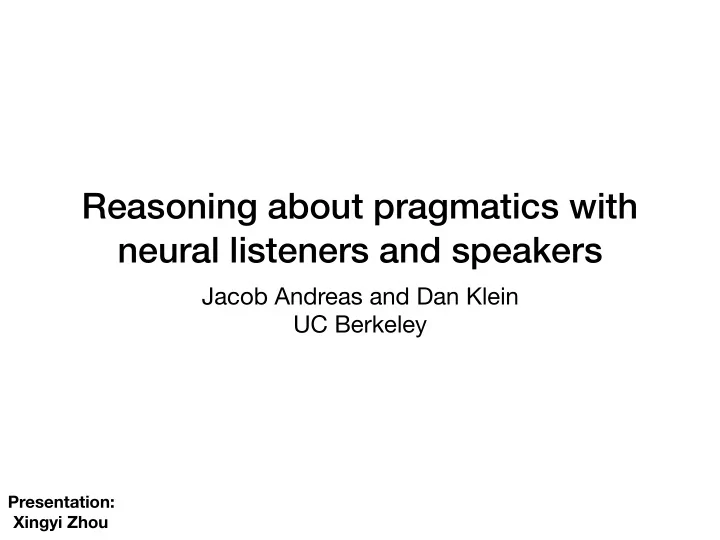

Reasoning about pragmatics with neural listeners and speakers Jacob Andreas and Dan Klein UC Berkeley Presentation: Xingyi Zhou
Goal: Reference Game • Input: A target image and a distractor image • Output: A sentence that distinguish target image from distractor image • Evaluation: Human evaluation on AMT the owl is wearing a hat the owl is sitting in the tree
Reference Game Formulation Defined on a speaker S and a Listener L 1.Reference candidates r1 and r2 are revealed to both players. 2.S is secretly assigned a random target t ∈ {1, 2}. 3.S produces a description d = S(t, r1, r2), which is shown to L. 4.L chooses c = L(d,r1,r2). 5.Both players win if c = t.
Previous Methods • Direct approach (supervised learning) • Imitate human play without listener representation. • No domain knowledge needed. • Require a large training samples, which are scarce. • Derived approach (optimizing by synthesis) • Initialize a listener model and then maximize the accuracy of this listener. • pragmatic free. • Require hand-engineering (on grammar) listener model. pragmatic: concerned with practical matters / it must be informative, fluent, concise, and must ultimately encode an understanding of L’s behavior
Overview of the Proposed approach • Combine the benefits of both direct and derived models. • Use direct model to initialize a Literal listener and a Literal speaker without domain knowledge • Embed the initialization with a higher-order model that reason about listener responses
Initialize the Literal Speaker(S0) • Only have non-contrastive captions for training • Image features: indicator features provided by the dataset, not CNN features but easy to replace • Use a decoder to recursively generate a sentence (similar to RNN) • The literal Speaker itself is su ffi cient for referring game. Slides credit: Andreas and Klein
Initialize the Literal Speaker(S0) Slides credit: Andreas and Klein
Initialize the Literal Speaker(S0) Training Testing Produce the sentence and its confidence score during testing Slides credit: Andreas and Klein
Initialize the Literal Listener(L0) • Random sample distractor image as negative sample. • Take n-gram feature as sentence representation. Slides credit: Andreas and Klein
Initialize the Literal Listener(L0) Slides credit: Andreas and Klein
Initialize the Literal Listener(L0) Training Testing Slides credit: Andreas and Klein
Reasoning speaker(S1) Slides credit: Andreas and Klein
Reasoning speaker(S1) :Trade of between L0 and S0 Slides credit: Andreas and Klein
Reasoning speaker(S1) • S0: Ensure that the description conforms with patterns of human language use and align with the image. • L0: Ensure that the description contains enough information and take account of the contrastive image.
Experiments - Dataset Evaluation: Human evaluation on AMT Slides credit: Andreas and Klein
Experiments - Baselines & Results • Literal: the S0 model by itself • Contrastive: a conditional LM trained on both the target image and a random distractor [Mao et al. 2015] Slides credit: Andreas and Klein
Tradeoff between speaker and listener models • Merely rely on Listener gives the highest accuracy but degraded fluency. • Add only a small speaker weight achieves a good balance.
Qualitative Results
Qualitative Results - contrastive • The model is able to produce contrastive description even though the speaker is trained on non-contrastive images.
Comments • Pros: • A good practice to combine two streams of the literatures. • All the sub-modules are several linear layers, making the system clear and e ffi cient. And the qualitative results are fairly good. • Cons: • The model achieve best accuracy with L0, making it hard to claim that language fluency is important for referring games. • The speaker is still not contrastive, this may lead to an inherent di ffi culty for fine-grained scenes. • The human evaluation is infeasible and unfair. Is there better evaluation for referring game? • The training is based on hand-craft features and not end-to-end.
Recommend
More recommend